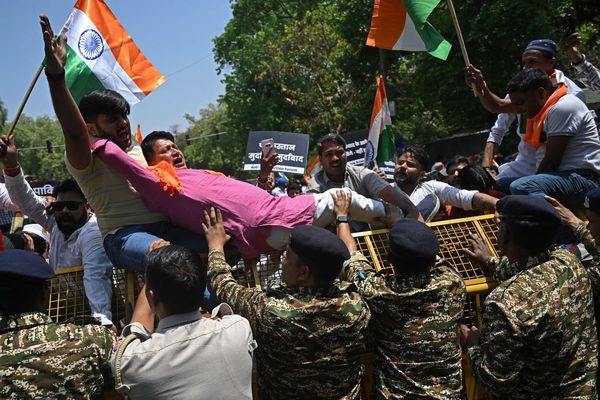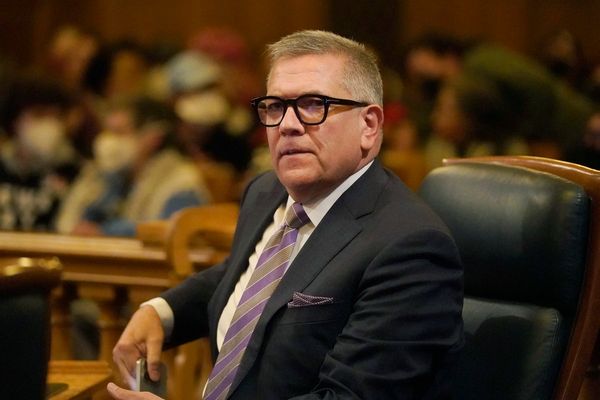
Photograph: Jason Pinas
John Adjako lets out a deep sigh when his thoughts turn to his income as a boatman. It has been dwindling for the past few months during the drought in the Upper Suriname region where he lives and where his boat is one of the dozens moored each day at the Atjoni jetty.
December generally sees a surge of local passengers and tourists heading to the interior of Suriname, a country on the north-east coast of South America, where the Amazon meets the Atlantic Ocean.
But that trade fell by at least half last year, a decline highlighted by the silence at the Atjoni jetty, where only a few people are waiting with their belongings. Because of the river’s extremely low water level, a distance usually covered in four hours now takes almost an entire day. Passengers have to get off with their luggage at most of the rapids.
“They find that tiring. So now people travel only when necessary,” Adjako says, as he prepares for the 45-minute trip to the village of Jaw Jaw. “It’s so dry that you can just walk across the river in some places.
“I haven’t seen this for decades. That is a real disaster, and we fear it will worsen. We are crying for rain.”
Atjoni is a village in Sipaliwini, Suriname’s largest province, 112 miles (180km) from Paramaribo, the capital. The jetty serves as the centre and main transfer point to the villages along the Upper Suriname River, where the population is predominantly Maroons of the Saamaka communities – descendants of enslaved Africans who escaped to Suriname’s interior.
The drought in Suriname began in early 2023, with severe conditions reported by February last year; wildfires spread, posing a major health risk. By August, the drought had extensively depleted natural water sources, forcing communities to rely on contaminated river water. This has led to the spread of waterborne illnesses, especially among children under five, as reported in Sipaliwini.
Health facilities and schools have been badly hit, with a lack of clean water disrupting medical services and education. Clinics report shortages of medical supplies and staff, as well as problems with basic sanitation, further aggravating the crisis. Erratic weather and consecutive crop failures have heightened food insecurity.
Rising food prices and transport costs from Paramaribo have left many households without adequate nutrition, increasing vulnerability among women, children and older adults.
***
Mugabe Antomoi, a member of the village authority of Abenaston, near Jaw Jaw, confirms the challenging situation in Upper Suriname. Growing crops has been particularly difficult in the interior region, where more than 300 families rely on subsistence farming for food.
“Not only the rivers but also the creeks where we get our drinking water are now bone-dry,” Antomoi says.
In Abenaston, the schools are only able to open for two or three days a week. “Teachers who have to come from the city have difficulty reaching their duty station. There is also no drinking water and water for toilets. We can’t do that to the children,” says Graida
According to a Unicef report in November on the country’s prolonged drought, communities in the interior have been severely affected. The drought has hit 52 villages and approximately 40,000 people across Sipaliwini, Upper Suriname, Tapanahony and Coeroeni, with about 70% of the population needing humanitarian assistance.
Health facilities and schools have been badly hit, with a lack of clean water disrupting medical services and education. Clinics report shortages of medical supplies and staff, as well as problems with basic sanitation, further aggravating the crisis. Erratic weather and consecutive crop failures have heightened food insecurity.
Rising food prices and transport costs from Paramaribo have left many households without adequate nutrition, increasing vulnerability among women, children and older adults.
***
Mugabe Antomoi, a member of the village authority of Abenaston, near Jaw Jaw, confirms the challenging situation in Upper Suriname. Growing crops has been particularly difficult in the interior region, where more than 300 families rely on subsistence farming for food.
“Not only the rivers but also the creeks where we get our drinking water are now bone-dry,” Antomoi says.
In Abenaston, the schools are only able to open for two or three days a week. “Teachers who have to come from the city have difficulty reaching their duty station. There is also no drinking water and water for toilets. We can’t do that to the children,” says Graida Tomati, a mother of several pupils in Abenaston. “If it continues like this, we will soon have no food.”
The situation has led many in Suriname to complain about the government because, in neighbouring French Guiana, a French overseas territory or département, the drought has not caused the same problems as it has over the border.
In the village of Apetina, home to the Wayana Indigenous people, children still enjoy a full-time education despite the drought and low water levels. But, according to Dijon Koemapu, an Apetina resident and campaigner for the Mulokot Foundation, a community organisation, that is not down to the Surinamese government.
The village sits on the Tapanahony River in south-eastern Suriname, about 60 miles from the French Guiana border, and its 300 inhabitants are reliant on foreign support.
“The children of Apetina and other Wayana villages in this area are in French schools,” says Koemapu. “If we have to wait for the government, we will get nothing,” he says, disappointed by the lack of help from the authorities.
Suriname’s government has not responded to a request for comment.
Henk Deel, a district commissioner for the Tapanahony area, says he expects central government to declare a state of emergency in Suriname’s interior.
“The situation is very serious,” he says, describing the drought as the most severe “in at least 20 years”.
Deel acknowledges that because the rivers are difficult to navigate, goods are increasingly hard to come by and prices are rising. “There is now a scarcity of food and fuel, and a reduced quality of medical supply in the area. But it is up to the national authorities to decide on this,” he says.
He adds that the French Guianese government has allocated €2m (£1.7m) to villages on the French side of the border, and Surinamese people and Maroons expect the same support from their government. “Now the authorities have to come in. It keeps getting worse,” he says.
***
Jerry Slijngard, head of the National Coordination Centre for Disaster Relief (NCCR), says his team has identified about 147 villages in need of aid. Among them are settlements of illegal goldminers from abroad. “We make no distinction between Surinamese and illegal foreigners. We help everyone,” he says.
The NCCR is working on a report to drive government action. If the state agrees with the proposal, a special situation may be declared. After that, according to Slijngard, the NCCR will launch a special operation. “It is a vast area that needs help so it will be a big, expensive and complicated operation,” he says, estimating the costs to be about £250,000.
About half of that amount will go to upgrading transport systems to tackle the complexities of getting around during the drought, which shows no signs of ending. “We estimate it will continue at least until June,” Slijngard says.
While the drought is partly attributable to natural variability, such as the periodic El Niño events that reduce rainfall in northern South America, scientists say the primary cause is the climate crisis, which has altered rainfall patterns, raised mean temperatures, and increased the magnitude of the natural variability as well as systematically changing trends over time.
Prof Sieuwnath Naipal, a hydrologist and researcher specialising in climate change at Suriname’s Anton de Kom University, says multiple factors contribute to the extreme drought, including deforestation in the Amazon and illegal goldmining.
“We cannot lose sight of climate change when looking at this,” he says, warning that the problems will continue to become more prevalent. “Human activities will continue to be scaled up, and forests will continue to disappear. When you add all this up, I don’t expect things to get better.”
Naipal calls on the authorities to adapt and consider options for managing the country’s water resources to prevent scarcity in the interior in the dry seasons. “We should not wait for things to get worse,” he says, suggesting the construction of small reserves and forest conservation as possible solutions.
Data from the World Bank’s Climate Change Knowledge Portal about Suriname’s meteorological record shows that there were 20 consecutive dry days in 2023, the second-highest number since 1997.
Sukarni Sallons-Mitro, a climatologist with Aurae Opus, an environmental organisation that tracks the weather in Suriname, says very high average temperatures have also been recorded in the dry and wet seasons, resulting in the historic drought in different parts of the country.
She says the minor rainy season, which began in December, has brought more frequent rainfall, “but that will not immediately fill the rivers and creeks. The water in the rivers and creeks is evaporating.”
“Suriname’s temperature has increased by about 1C [1.8F] in the last 50 years. We have to be prepared for that,” says Sallons-Mitro. “The government must act now before it gets worse.”







